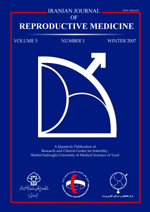
|
International Journal of Reproductive BioMedicine
Research and Clinical Center for Infertility, Shahid Sadoughi University of Medical Sciences of Yazd
ISSN: 1680-6433
EISSN: 1680-6433
Vol. 11, No. 6, 2013, pp. 453-458
|
 Bioline Code: rm13057
Bioline Code: rm13057
Full paper language: English
Document type: Research Article
Document available free of charge
|
|
|
International Journal of Reproductive BioMedicine, Vol. 11, No. 6, 2013, pp. 453-458
| en |
The frequency of Yq microdeletion in azoospermic and oligospermic Iranian infertile men
Zaimy, Mohammad Ali; Kalantar, Seyyed Mehdi; Sheikhha, Mohammad Hasan; Jahaninejad, Tahere; Pashaiefar, Hossein; Ghasemzadeh, Jalal & Zahraei, Mahnaz
Abstract
Background: About 15% of couples have infertility problems which 40% of them are related to the male factors. Genetic factors are candidate for about 10% of male infertility conditions. Among these, AZFa, AZFb, AZFc and AZFd regions on the Yq are considered most important for spermatogenesis. Microdeletions of these regions are thought to be involved in some cases of azoospermic or oligospermic infertile men.
Objective: We studied the prevalence of AZF microdeletions among Iranian infertile men with non-obstructive azoospermia and oligospermia.
Materials and Methods: A total of 50 Iranian azoospermic and oligospermic infertile men were selected for case group and 50 men with normal spermogram as control group. The molecular study of Y chromosome microdeletions was done by multiplex polymerase chain reaction (M-PCR) method by using of 13 sequence tagged site (STS) markers from AZF region.
Results: Four (8%) patients showed Y chromosome microdeletions among case group, deletion in AZFc region was the most frequent (80%) followed by AZFb (20%), in AZFa and AZFd region we did not detect any deletions. No deletion was detected in control group; the ratio of Y chromosome microdeletion in azoospermic men was higher than this ratio in oligospermic men [19% (3/16) among azoospermic men and 3% (1/34) among oligospermics]. Serum FSH level in men with microdeletions was higher than this level in men with no deletions (p=0.034).
Conclusion: Because of relatively high prevalence of microdeletions on the long arm of Y chromosome among Iranian azoospermic and oligospermic patients, screening of this microdeletion may be advised to infertile men particularly azoospermic and oligospermic men before using assisted reproductive treatments.
Keywords
Male infertility; Multiplex polymerase chain reaction; AZF microdeletion
|
| |
© Iranian Journal of Reproductive Medicine
Alternative site location: http://www.ijrm.ir
|
|
